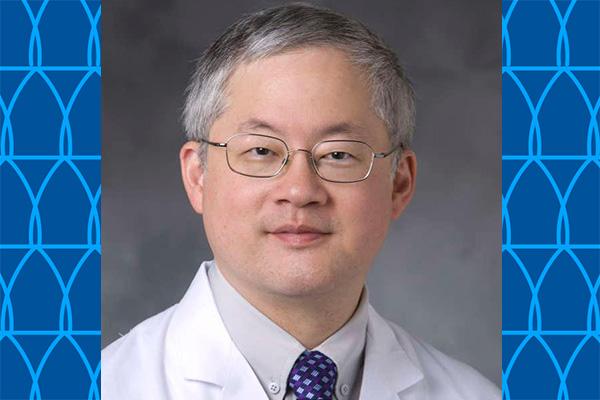
Appointing and promoting faculty involves much more than simply reviewing CVs. Just ask James Tcheng, MD, associate dean for academic appointments. In this month’s EDI Spotlight, Tcheng gives a glimpse into the world of faculty appointments and promotions, offering insights into why it’s important to incorporate equity, diversity, and inclusion into the appointments, promotion, and tenure (APT) process.
He shares how his involvement with two committees led to a new framework that is changing how the school considers EDI work when promoting faculty. Tcheng also reveals his love for all things related to information technology.
You currently serve as associate dean for academic appointments. What does this role entail? What does a typical day in this role look like for you?
As associate dean for academic appointments, I am responsible for all faculty appointments in the School of Medicine (SOM). On a daily basis, this includes review of all pending new faculty appointments and oversight of the work of the SOM Appointments, Promotions, and Tenure (APT) office. Policies, procedures, documents, forms, templates, and information technologies related to appointments, annual review, promotions, tenure, and even retirement are under my purview.
When and how did you first become interested in EDI-related work?
For most of my adult life, I believe I have maintained a “north star” that values equity, diversity, and inclusion. In 2017, I was appointed to an ad hoc committee to revise the SOM faculty promotion process. While that was relatively early in Duke's APT EDI journey, the committee provided a platform to begin expressing EDI constructs in operational terms, at least in terms of APT. I am grateful that the committee recognized the opportunity and included EDI in the foundations of our Career Track and Tenure Track promotion guidelines.
As part of the school’s Moments to Movement Strategic plan, in 2021 the Faculty Antiracism and Equity (FARE) committee reviewed the processes for appointments, promotion, and tenure (APT) and made recommendations for integrating equity, diversity, and inclusion into the fabric of APT. What was your role on this committee? What inspired you to get involved?
First, credit must go to Ann Brown, MD, MHS, for engaging the FARE APT subcommittee in a thorough and thoughtful manner. The FARE APT subcommittee members were Gerald Bloomfield, MD; Wei Jiang, MD; Christopher Newgard, PhD; and Gregory Sawin, MD, MPH. While neither of us were formal members of the FARE APT subcommittee, we signaled our commitment to following through and operationalize the recommendations of the subcommittee. The FARE APT subcommittee report shaped many of the process and procedure specifics related to annual review and promotion in place today.
What are some of the recommendations that came out of this committee? Have you been able to implement any recommendations so far?
There were multiple recommendations proposed by the subcommittee. I think the key ones included the following: improve the transparency and consistency of the criteria for promotion; expand the definition of scholarship to recognize the depth and breadth of promotable activities of our faculty – not just as traditional publications but expressions of scholarship in non-traditional domains such as advocacy and EDI; include assessment of EDI engagement and contributions in the faculty annual review; and the authoring of a guidance defining promotable activities in the EDI sphere.
Why was it important to incorporate scholarship around Justice, Equity, Diversity, Anti-Racism, and Inclusion (JEDAI) into the APT process?
First, the types of scholarship for consideration as promotable activities had to be formalized to include not just discovery (typically expressed as publication of the findings from original research and investigation) but also the scholarship of integration (interpreting use of new knowledge across disciplines), application (aiding society and professions in addressing problems), and teaching (studying the process of education / evaluating effectiveness). This was accomplished with the 2020 update to the promotion criteria. This scholarship framework is openly available via content on the APT website. What we did with the JEDAI framework was to articulate, mostly by example, how those four scholarship domains could be expressed by our faculty via JEDAI work done in the research, clinical, service / administration, and education domains. We also included examples of the assessment of scholarship impact, a key requirement of the promotion framework. Through the JEDAI guidance we were thus able to articulate how a faculty member could follow either the Career Track or the Tenure Track as a pathway to promotion.
Will this work to change the framework of the APT process affect others within the academic medical center beyond faculty? If so, how?
That is the intent. The faculty lead by example – the hope is that we reach all within the medical community, both at Duke and beyond. We are looking to our faculty for setting expectations and standards for the entire medical campus.
Do you see this framework serving as a model for other medical schools? What can other schools learn from your work?
Definitely. Duke is recognized as a leader in EDI and other medical schools are looking at our initiatives as they craft their respective approaches. In May of this year, Greg Sawin, MD, MPH; Mara Becker, MD, MSCE; Kevin Thomas, MD; and I were given the opportunity to present our approach at the Association of American Medical Colleges (AAMC) Group on Diversity and Inclusion / Group on Faculty Affairs annual meeting via a presentation entitled “Integrating Equity, Diversity, and Inclusion into the Fabric of APT.” The presentation was well-received and reflects Duke leadership in this domain.
What passions or hobbies do you have outside of work?
Several of my passions blend with my Duke work – for example, I have a keen interest in all things related to information technology, computer programming, and Web-based constructs for information exchange. I have three different home automation systems in my home! I also enjoying gardening, biking, and downhill skiing.